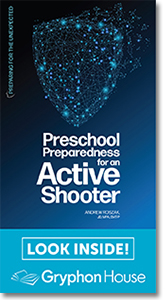ExchangeEveryDay Past Issues
 << Previous Issue
| View Past Issues | | Next Issue >>
<< Previous Issue
| View Past Issues | | Next Issue >> -Leo F. Buscaglia
Many early childhood programs are welcoming children and families back into the physical classroom this week, but many are also still connecting remotely. Marybeth Murray graciously shared this article to help those programs still dealing with remote connections. Thank you Marybeth!
Opportunities Abound, by Dr. Marybeth Murray
No one could have imagined our lives changing so drastically, in such a short amount of time, as a result of COVID-19. Families are now facing unique challenges, as many parents are losing their jobs due to the pandemic. There is no playbook for putting the health and well-being of our own children, students, and families first during a crisis of this magnitude. During this time, many school staff struggle to continue to work remotely, while also providing administrative and educational services to the children and families in their care. In this time of uncertainty, it is important for everyone to look at what we can do to decrease the amount of stress that we face as educators.
As a school administrator and part-time college professor working to prepare early childhood educators to enter the field, I am inundated with phone calls and emails from teachers and college students who are desperate for answers on how to provide support and rich educational content for the young children they are teaching. My college students and teaching staff report that their lives have been upended; they need support on best practices to make their virtual classrooms safe and welcoming spaces and an increasingly important community for their students and families. Some teachers are feeling overwhelmed and lost. As educators in an era of turmoil, we can provide a safe place for our students from a health, ecological, and political perspective, which not all industries can provide, and we can use our passion and encouragement to help others succeed.
One of the biggest challenges that teachers have shared with me is being responsive to student needs while trying to stay present for their own families while teaching from home. My advice to them is to be gentle with themselves. I tell them to give themselves time to adjust to this new way of teaching and to celebrate their victories, no matter how small. I let them know it is normal to have a lot of unstructured time right now. It will give them the opportunity to learn more about the children in their care, as well as their own children.
Another challenge teachers face is learning how to teach remotely. Teachers must suddenly change the entire way they deliver content to their students. Restructuring their teaching style in the classroom and transitioning to a completely different setting, all while worrying about what happens next during this rapidly changing time, can leave teachers doubting their ability to provide an effective educational experience for their students. To improve and implement their online teaching programs, teachers must be creative in their offerings and delivery of instruction. Since physical isolation has quickly become our way of life, staying connected with friends, colleagues, and other people is a sure-fire way to help decrease some of the anxiety and fears that educators are experiencing.
Prior to her state’s order to stay home, pre-K teacher and mother of two Dana would take her children, Max and Eva, on nature walks in the park or the beach, and discuss various ecosystems, including the water cycle and how ecological systems affect the lives of people and animals. She decided to use these activities to meet the science standards for her class. She also recorded these interactions and shares them online with the families of the children in her pre-K classroom. Her students are excited to watch their teacher’s outdoor adventures, and parents are excited that their children can still have a connection with their teacher while continuing to learn at home.
Tamara, a mother and pre-K teacher, addresses the topic of science by creating experiments with her daughter. She created videos in her garden that involved collecting various bugs and living creatures to share with her students via her school’s online learning platform. She is supporting her own child in making observations to build their scientific thinking skills. Tamara also encourages parents to assist their children with drawing and painting pictures of their indoor and outdoor settings, in order to create a book to share with family or friends.
Considering physical education, teacher Liz capitalizes on social media by sending her students’ parents links for different sites that contain activities such as yoga or dances that teach children different ways to move their bodies and sharpen their gross motor skills. She also sets up teleconference meetings with her students and shares her screen to have children watch video tutorials with her to learn new songs or play instruments. Parents are always encouraged to participate.
The issue of equity is also important for educators to address. We want to be sure to keep in mind that some families have access to more resources than others. One of our families may have the ability to access technology on a regular basis, while another may have more than one child in the home, which requires sharing devices with siblings and/or a parent who is working from home. For some families— especially those facing layoffs and job loss—schoolwork is not going to be a priority. Basic survival is the order of the day. Maslow’s hierarchy of needs will have to be considered for all children.
There has never been a better time to think outside the box about how our children can learn in unique ways. Never have creativity, choice, self-directed learning, discovery, and inquiry opportunities been as available as they are now for our children and students—perhaps most especially for those in public schools. As educators our goal, as always, is to inspire a love of learning. Providing a sense of hope, and having a healthy attitude peppered with plenty of listening and calmness, will support our students during this chaotic era.
First and foremost, we need to take care of each other. We must do our best to maintain our optimism, uplift our students and families, and let them know we will be here for them and will continue working with them—now and in the future—to ensure their child’s success.
Engaging Families in Early Childhood Organizations to get this title for 20% off |
|
|
|
Offer valid through June 10, 2020 at 11:59 pm Pacific Time. |






Comments (1)
Displaying 1 CommentDay Spring Head Start
Baltimore, MD, United States
Greeting Dr. Marybeth Murray
I enjoyed your expression about what is going on in our families and student and our life during this unknown situation. As a teacher and a mother, I am facing the same difficulty like the others, but I never lost my hope. I am trying to be positive all the time with my family, my students and colleagues. Every day is another day of life experience and learning condition. I am not an electronically person, but I learned how to use zoom to participate and communicate with my students. I made an schedule for my family to have routine everyday. I Teach them how to take care of their health and safety. We have to learn how to be survival not the victim.
All the best
Firoozeh
Post a Comment